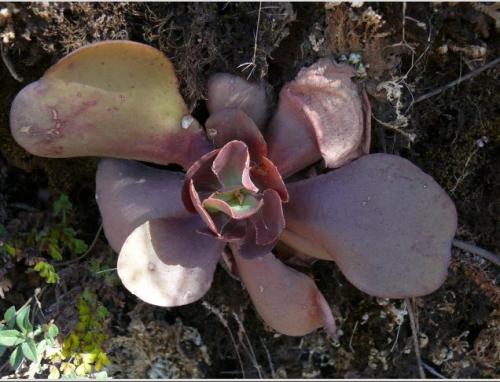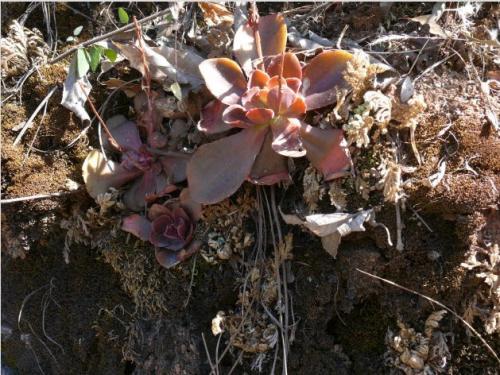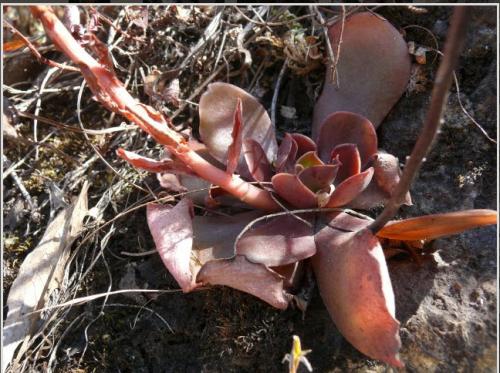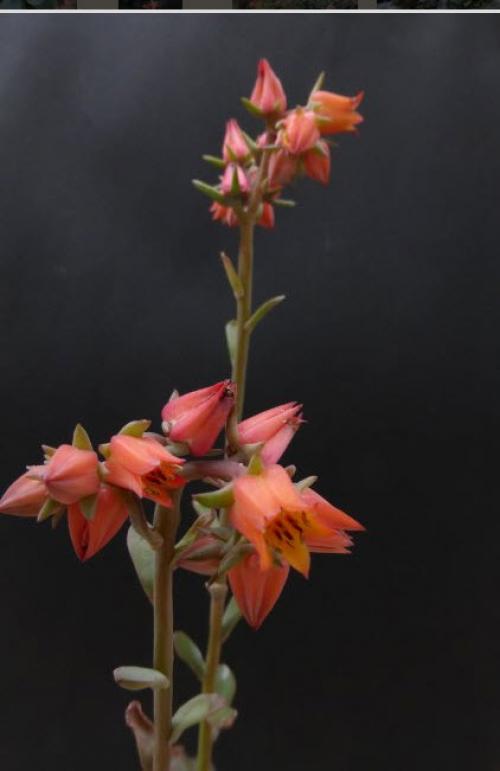AURANTIACA Reyes, Gonzáles-Zorzano & Brachet, 2011
Series * > see below
Type : Reyes 6012, Tepacoya, 17 km north of Taxco, Guerrero, Mexico, 8 December 2007.
Etymology : referring to the colour of the petals.
Distribution : Mexico (Guerrero), only known from the type locality.
Description by Reyes, Gonzáles-Zorzano & Brachet in Cactaceas y Suculentas Mexicanas 56: 68-74. 2011 :
A glabrous plant.
Roots fibrous, main root somewhat thickened.
Stem short, to 2 cm, 9 - 10.5 mm in diameter, not branching.
Rosettes 9 - 14 cm in diameter in winter, in cultivation in summer to 24 cm across.
Leaves 3 - 6.5 cm long, 1.6 - 2.2 cm broad (in cultivation even 12.4 cm long), 2.8 - 4.3 mm thick, narrowly ovate to lanceolate, mucronate, pinkish green to greyish green, yellowish to fleshcoloured, fleshy, glossy, margins entire, slightly undulate, the small ones reflexed and stiff, the summer leaves spreading and flexible.
Flowering stem 27.5 - 54 cm tall (cincinnus included), 3.1 - 3.7 mm thick at the base, 13 - 29 bracts, rather crowded below, obovate-lanceolate, acute, ascending, 1 - 3.5 cm long, 0.8 - 3 cm broad, 1.5 - 2 mm thick, slightly reflexed at the tip, base spurred, inflorescence in the wild a helicoid cincinnus (in cultivation often with two helicoid cincinni) with 8 - 10 flowers, bracteoles lanceolate, 5.6 - 7.5 mm long, 2.4 - 2.6 mm wide, base spurred, greenish yellow, pedicels 4.5 - 7 mm, 1.2 - 1.7 mm thick at the base, spreading to ascending, pale green.
Flowers : Sepals spreading to ascending, unequal, triangular - lanceolate, acute, 3.5 - 4.6 mm long and 1.6 - 1.8 mm wide at the base, corolla conical to cylindrical, 9 - 11 mm long, ca 6 mm in diameter at the base, petals united at base, lanceolate, 9 - 10 mm long and 3 - 3.6 mm broad, slightly reflexed at the tips, keeled, yellow orange, nectar cavity distinct.
Note :
* The authors suggest that E. aurantiaca should be included in series Gibbiflorae. However the latter is for plants with short to medium tall stems and paniculate inflorescences. It is doubtful whether an acaulescent species with a helicoid cincinnus should really be placed in series Gibbiflorae.
First published in Cactáceas y Suculentas Mexicanas 56(3): 70 (68-74), ills., 2011




Photos Gerhard Köhres